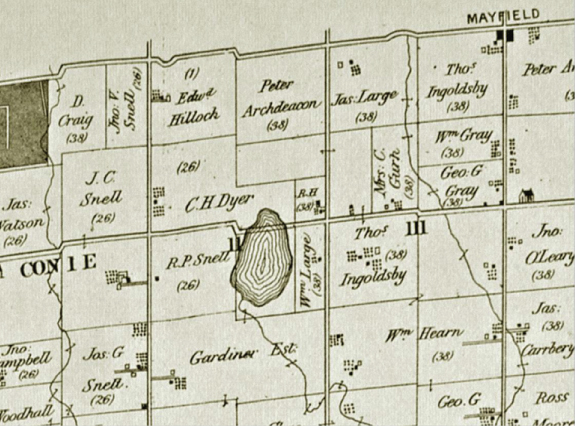
The Heart Lake Mystery
I had always wanted to feature Snell’s Lake in my Beneath the Alders series. Though the Etobicoke Creek is the dominant body of water within the series, Snell’s Lake (now Heart Lake) held a special appeal for my aunt, Jessie, the inspiration behind the series. It was in this lake that she paddled her first canoe; near its shores that she learned to swim. The opportunity to relay her real life experiences with some fictional stories presented itself with the 1914 leaving party of her Winnipeg cousins. As I tapped into The Beleaguered the details of the vehicles that transported her family members to the site, the food hampers they carried, the impromptu baseball game they played and the nearby church picnic, I felt I had done justice to a favoured place of Jessie’s childhood.
There was only one detail missing. I called my Brampton born and bred father. I told him about what I had written and then asked: where was the entrance to the parkland that surrounded the lake?
“The entrance?” my father asked. “I assumed this was all fiction. In real life no one would have accessed that land at that time. It was not fit for humans.”
I conceded the church picnic and baseball game were of my imagination but the rest was based on what the by then deceased Jessie had told me. “I think her memory was faulty,” he said. “There is no way anyone could have swam much less picnicked there. At that time, the area was overgrown, polluted and boggy.”
I had learned in my writing process to heed these corrections of my father. Though he walked the streets of Brampton as a child forty years after Jessie did so, I learned that if a street or building did not exist in his time, it often did not exist in hers. I checked my notes of my conversations with Jessie and notes that Jessie had written herself. Here is what she wrote.
I learned how to swim at Snell’s lake (now Heart Lake). I learned using 2 cedar logs strapped together to keep me up—no instructor. When I could swim 50 yards, my father said I could go in a canoe. Elizabeth, my friend, had a beautiful red canoe. I learned fast.
For those of you not familiar with the lake, let me tell you about it. Heart Lake exists within the 418 acre conservation area of the same name. It is located within the watershed of the Etobicoke Creek, within the current city limits of Brampton. Not surprisingly, it takes the shape of a heart. On a hot Saturday or Sunday these days, it is filled with hundreds if not thousands of people picnicking, swimming, fishing, hiking and more. If Jessie was right, these activities originated over a hundred years ago. If my father was right, the origins were much more recent.

I donned my research hat and poured over notes I had previously taken about the lake. After some google sleuthing, I added to my sources a 2014 report written by David Laing. It was a submission to the City of Brampton for the purpose of obtaining a cultural heritage landscape designation for the portion of Heart Lake Road between Sandalwood Parkway and Mayfield Road.
Here is what I learned. The lake, like many in Ontario, was formed over 10,000 years ago following the last ice age. From about 7,000 BC to 1,000 BC, the water and the area around it were used by nomadic aboriginals for hunting and fishing. The archaeological findings and trappings of campsites that have been unearthed in the area indicate that it was likely used as a stopover site for moving tribes.
In the 1800’s when the area was opened to settlement, the lake took on the name of those who owned land abutting it. Thus at times it was referred to as “Dyer Lake” for Charles Dyer who, based on the 1859 atlas, owned land abutting the northwest quadrant of the lake; and as “Snell’s Lake”, for John Snell who at that time owned land abutting the south west and north east quadrants of the lake. An 1877 atlas showed that the ownership of some lots had changed, but while both a Dyer and a Snell continued to have abutting lands, the lake became more universally known as Snell’s. This may have been in part because the lake was in the vicinity of an area that had come to be called Snelgrove, a name selected on the basis of the amount of mail received by a resident named Snell, a local breeder of “blooded hogs”.

The water in the lake at this time was pristine. Perkins Bull, a noted Peel County historian, stated that in 1913 –the year before my fictional leaving party--the water from Snell’s Lake was absolutely pure. This was a good thing. Brampton had been using the lake as a source of water since at least 1881. The lake provided enough water to meet not only the residential needs of Brampton but also some industrial needs. Eventually, water levels in the lake began to recede and artisan wells were sunk to supplement it.
A change occurred in the following decade. According to Laing, in the 1920’s the lake was purchased and converted to a “commercial duck-raising enterprise”. The lake became infested with dead plants, uneaten food and faeces making it “not fit for swimming by the end of May each year” (i.e. just as the swimming months began).
Based on the writings of Perkins Bull in From Amphibians to Reptiles, in the 1930’s the lake (by then known as Heart Lake) and the land around it were owned by Colonel A.E. Taylor. Taylor reported that the lake was occupied by a pre-historic serpent responsible for spurting into the air columns of water fifteen feet high along a speeding horizontal plane of fifteen or twenty feet. More reliably, Bull reported that the area formed the habitant for among others, turtles, toads, lizards, snakes and salamanders.

In 1956 the Heart Lake Conservation Area was created by the Etobicoke Mimico Conservation Authority, the authority formed in 1946 and referred to in the article in this newsletter on the Etobicoke Creek. The lake and lots around it began to be purchased resulting in the reopening of the lake for recreational purposes.
My conclusion: my father’s childhood recollections were correct, but Jessie’s likely were too. Heart Lake, which is now a treasure to so many, was not available to my father as a child but it seems it was to Jessie.

To Order Your Copy of
The Mending
select one of these links.


